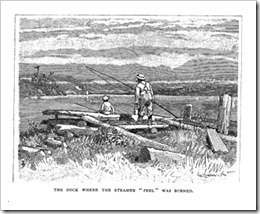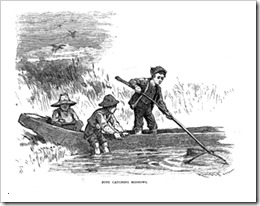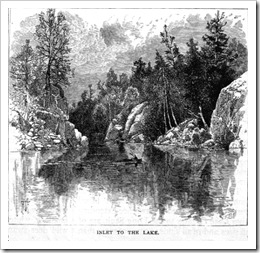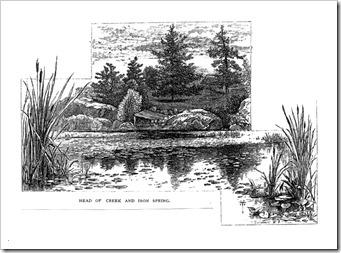In the February issue of Thousand Islands Life Magazine we introduced Howard Pyle, one of North America’s premier illustrators. One of his early assignments was to write an article on the Thousand Islands for Scribner’s Monthly.
Pyle spent a month sketching and taking notes while he stayed at the Thousand Island House in Alexandria Bay, N.Y. His finished work was titled "Among the Thousand Islands" and was published in April 1878.
[All illustrations in this article are from the Robert and Prudence Matthews Collection. Click on each photograph to enlarge]
In this issue, Part III in our series on Thousand Island illustrators, we introduce four artists who contributed to Howard Pyle’s article for Scribner’s Monthly.
Henry Wolf
Henry Wolf was born 1852 in Europe and immigrated to the United States in 1870. He was an illustrator, painter [watercolors] and engraver. To be both an illustrator and engraver gave Wolf the advantage of being able to make adjustments to his drawings while he engraved. He studied in Paris, France but spent most of his working life in New York State. His art appears in many museums including the Fine Arts Museum of San Francisco, the Cleveland Museum of Art and the Smithsonian American Art Museum. He also lived during the period known as the “Golden Age of American Illustrators.”
Wolf not only did the woodblock engraving for Pyle’s drawing titled “Cooking a Camp Dinner” [see the Pyle article in the February issue of Thousand Islands Life] but also contributed three illustrations to the article. The drawing of “Devil’s Oven” is signed “H Wolf” while the other two are signed “H Wolf sc.” Speculation only but my guess is that the two signed “H Wolf sc” were simply engraved, not from sketches, but from Wolf’s imagination and memory of the area. The Wolf illustrations are shown to the right and below.
  |
| Illustrations by Henry Wolf and signed “H Wolf sc.” |
The two letters “sc” [sometimes written “Sc”] is an abbreviation for the word “scrulp” [he engraved it]. Occasionally the engraver would sign only his name without using the label “sc” causing confusion as to who was the artist and who was the engraver.
Julian Oliver Davison
Another contributor to Pyle’s article was Julian Oliver Davidson, born 1853 but passed away at the early age of forty one. He too spent most of his life in New York State.
As a youngster Davidson took a number of sea voyages to Cuba with his father. Later, when he was seventeen, he hired on as a crew member aboard an ocean going steamer that was the first American ship to pass through the Suez Canal. Davidson loved the sea and these experiences provided him with a strong nautical background for his art. He is well known as a naval illustrator but it is his oil paintings that have earned him accolades. He painted on canvas specializing in historic maritime scenes such as the Battle of Lake Erie and naval engagements of the Civil War. Davidson did extensive research prior to painting these scenes. Some of his work was done on large canvases fifteen to twenty feet long. Years ago one such painting hung in the Plaza Hotel, New York City but its whereabouts now is unknown. In fact, some believe over half of his paintings have yet to be discovered. Museums fortunate to possess his art today include the Erie Maritime Museum, the Hudson River Museum and the United States Military Academy Museum.
Three of the four illustrations included in Pyle’s article are shown below. They are ca. 1878 and thus were engraved on woodblocks.
The first image is signed “J Davidson” in the lower right hand corner.
The second illustration pictures the steamer T. S. Faxton built in 1874 by Simon Johnston of Clayton, New York. It was destroyed by fire in 1901. The skiffs tied to the small steamboat may be fishing guides hitching a ride to a hotel to pick up their patrons for a day of fishing. A guide’s duties could include rowing five miles or more, cleaning the fish and then cooking a shore dinner for which they could earn three dollars a day. Davidson signed the illustration below in the lower left-hand corner. The engraver’s name is in the lower right-hand corner.

The more research done on artists who contributed to the Pyle article, the more one realizes that these were some of the very best illustrators of that time. To me it poses the question “who or what brought such talent to the Thousand Islands during that time”? Obviously the beauty of the Thousand Islands had to be a contributing factor but was that the complete answer? My guess is Dr. J. C. Holland [pictured below], editor of Scribner’s Monthly at the time, put the project together. He most likely commissioned Wolf, Davidson, Moran and King to provide additional illustrations for the Pyle article.
In 1878 “Bonnie Castle” in Alexandria Bay was the summer residence of Dr. and Mrs. J. C. Holland and is pictured below. The illustration was done by Davidson who signed it in the lower left-hand corner.
Thomas Moran
Thomas Moran [1837 – 1926] is another who fits the description “one of the best.” He was born in England but spent most of his life in the United States. During the 1870’s and 80’s he spent a great deal of time in the western United States and it is his western art for which he is now famous. Although he was a pen and ink illustrator, he preferred to paint with watercolors but also painted with oils.
Today his art is held in over one hundred museums including the Metropolitan Museum of Art in New York City, the Philadelphia Museum of Art and the Phoenix Art Museum.
Moran did not sign the two illustrations [shown below] with his name nor his initials. Instead he used a monogram in place of his signature. Then how does anyone discover the identity of the artist one hundred and thirty years later? Forget the details as it would take too long to explain but it amounts to one part computer, one part persistence and a whole lot of luck. If you really squint, his monogram is the letter “M” with an arrow going down through the middle.
  |
| Illustrations by Thomas Moran signed with a monogram |
Francis Scott King
The fourth illustrator to contribute to the Pyle article was Francis Scott King, born 1850. He drew “The Thousand Island House” which he signed “FSK” in the lower right-hand corner. King was both an artist and an engraver and while he did not use “sc” after his initials in this illustration, it’s likely he both drew and engraved the picture. King doesn’t seem to have had the reputation the previous illustrators enjoyed but still his art is considered worthy enough to be included in the Smithsonian American Art Museum.
Maybe these four artists and Pyle all visited the Thousand Islands at the same time.
By Robert L. Matthews.
Robert L. Matthews and his wife Prudence (Hooked on Prudence) have one of the most extensive collections of Thousand Islands memorabilia. For the past eight seasons the Matthews generously loaned their collection to the Antique Boat Museum in Clayton, NY. Bob is the author of two popular books: Glimpses of St. Lawrence Summer Life: Souvenirs from the Thousand Islands: Robert and Prudence Matthews Collection, and in 2009 he published A History of the Thousand Islands Yacht Club. When not at their beautiful River cottage at Fisher’s Landing, they live in St. Petersburg, Florida.
Editor’s note: Our thanks to Bob Matthews for sharing both his illustration collection as well as his knowledge. I have often referred to these illustrations when making presentations about the islands, never realizing who the artists were, nor the role the Thousand Islands played in their artistic portfolios.